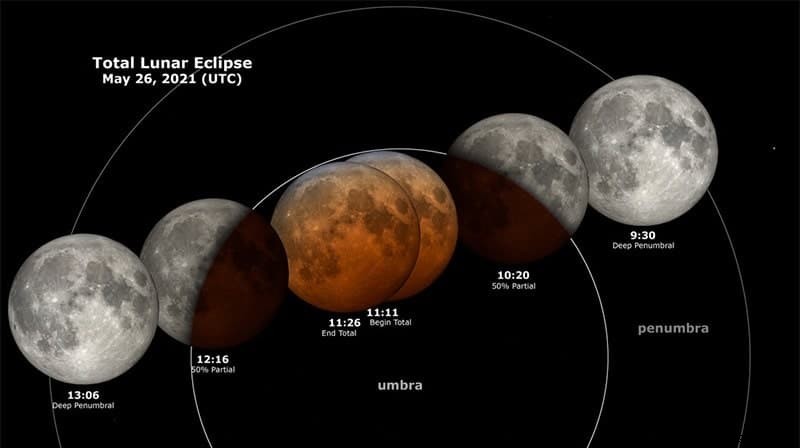In a few days, a cosmic event will delight all observers in the sky:a total lunar eclipse. During this event, the Sun, Earth, and Moon are precisely aligned, giving the earthly eyes a spectacle often called the Blood Moon. This name comes from the glowing hue of the moon during the eclipse. But where does this curious color come from?
The only total lunar eclipse of the year will illuminate the sky this Wednesday, May 26, when the full moon (a super moon due to the proximity of the satellite to Earth) will pass through the shadow of the Earth. During the lunar eclipse of the so-called “Blood Super Moon,” the face of the Moon will take on a brick-red hue. The glowing glow is the most impressive of the three types of lunar eclipses (the other two are called partial and penumbral).
A total lunar eclipse only occurs when the Sun, Earth, and Moon are perfectly aligned. When the Moon moves in the outer part of the Earth’s shadow, becoming completely surrounded by the darkest part of that shadow, then why doesn’t the Moon appear dark? Where does this glowing glow that gets its name come from?
Imagine standing on the moon, looking at the Earth during the spectacular event. When the Earth is directly in front of the Sun - preventing the Sun's rays from illuminating the Moon - you will see a fiery edge encircling the planet.
Even though our planet is much smaller than the Sun, the light from our star curves around the edges of the Earth. This light is reflected on the moon. But not before it passes through our atmosphere, which filters shorter wavelength blue light, allowing reds and oranges to move freely toward the moon. Which then appears red.

The Moon is not always completely hidden behind the shadow of the Earth. During partial lunar eclipses, the Sun, Earth, and Moon are slightly shifted in alignment, so that the shadow of our planet engulfs just a portion of the Moon. An observer of the novice sky might not even notice the third type of lunar eclipse, the penumbral type, in which the Moon is in the penumbra of the Earth, that is, its faint outer shadow.>
Wednesday’s total lunar eclipse is expected to be visible in Australia, parts of the western United States, western South America and Southeast Asia. Other parts of the world, including the entire United States, will be able to see at least some stages of the lunar eclipse, including its partial and penumbral phases.
For the other types of lunar eclipses, the next three penumbra eclipses will occur from May 5 to 6, 2023, March 24 to 25, 2024, and February 20 to 21, 2027. The next total lunar eclipse, which is expected to be visible parts of Asia, Australia, much of North America, South America, the Atlantic, Indian and Pacific Oceans, and Antarctica. May 16, 2022.